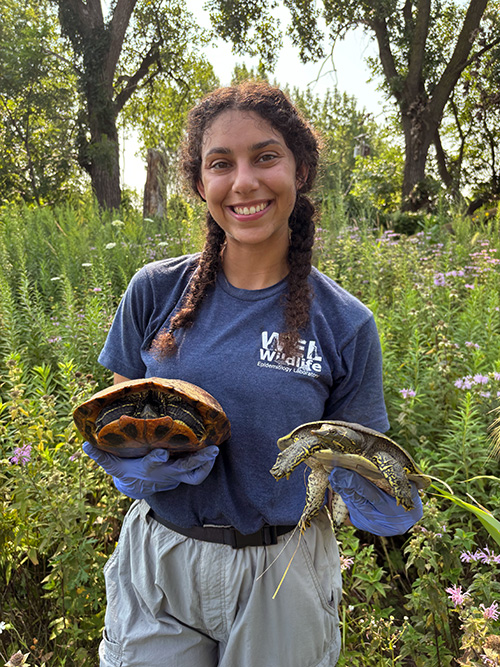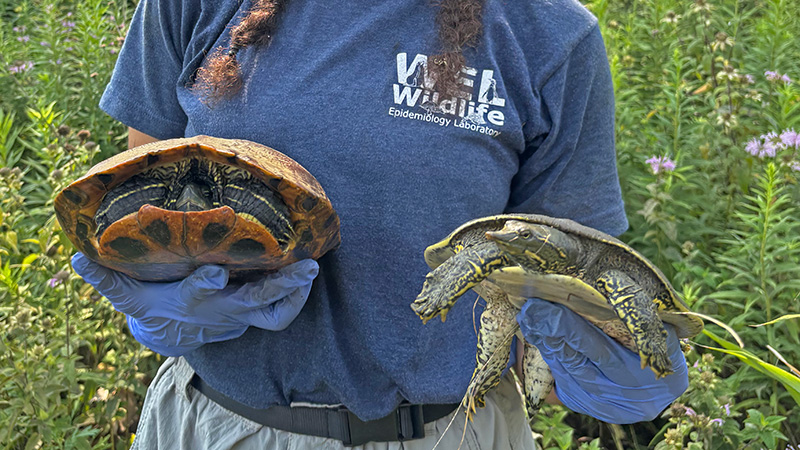Every spring and summer, students from the University of Illinois College of Veterinary Medicine venture into Illinois forests and waterways to save the world … one turtle at a time. The veterinary students work in teams to monitor the health of free-living turtles under the leadership of Dr. Matt Allender, founder of the college’s Wildlife Epidemiology Laboratory (and the person who coined the phrase “saving the world, one turtle at a time”).
This summer, Jaime Lyke worked with another veterinary student on the Cook County aquatics team, one of six groups studying different turtle species or locations. “Turtle teams” have been in the field collecting data since 2013.
Lyke shares some background on the how and why of her summer job.
Blanding’s Turtles: An Endangered Species

All the students on the turtle teams for the Wildlife Epidemiology Laboratory receive practical training in techniques needed to investigate wildlife diseases. These include trapping and safely handling the animal subjects, measuring and recording their physical attributes, and drawing blood or taking other samples.
Lyke’s research project focuses on the levels of lipid-soluble vitamins in Blanding’s turtles, an endangered species in Illinois. Her team hopes to establish the normal levels of vitamins A and E by comparing those with vitamin D and calcium absorption. The data they collect could lead to strategies for increasing the nutritional health, and therefore the population, of Blanding’s turtles in northern Illinois.
The Blanding’s turtle measures roughly 7 to 10 inches long. They are mostly dark to black, with a distinctive bright yellow chin and throat and yellow flecks along their upper shell, or carapace. A semi-aquatic freshwater turtle equally at home on land or water, it inhabits wetlands in parts of the upper Midwest, New York, New England, and southern Canada. Their preferred habitat featuring shallow, clear water is increasingly threatened by fragmentation or destruction.
These turtles fascinate longevity researchers because they show negligible signs of aging or senescence throughout their lives and are capable of healthy reproduction for an unusually long time.
“By studying Blanding’s turtles, a species native to the northern half of Illinois, we track an indicator of the health of these aquatic environments,” Lyke explains, “This species of turtle is shy and less outgoing when meeting new people. They tend to hide in their shells when samples are collected, but once you get them out of their shell, they are friendly and relatively easy to work with!”
A Day in the Field
Lyke and her partner start each day bright and early at 6:30 a.m. to check on their turtle traps. They then perform a “work-up” on each turtle that has been caught.
“With every turtle we catch, we collect blood samples and swabs and perform a physical exam. Then we record all the data on our iPads provided by the Wildlife Epidemiology Laboratory,” Lyke explains.
“Along with the physical exam, we will notch or microchip the turtles to help us identify if a turtle has been recaptured,” Lyke states, “We take photos of the face, top of the shell, and plastron (the turtle shell “belly”) and describe any abnormalities in detail.”
After a morning of catching and sampling turtles, the team heads back to the lab to analyze the samples collected. “Packed cell volume, total solids, erythrocyte sedimentation rate, absolute cell counts, and plasma volume are immediately tested and recorded for each sample we collect,” Lyke explains.
Turtle Traps
Lyke and her partner set their traps on Mondays in the field site for that week, then remove the traps on Fridays.
“Traps that we use are netted and hoop-structured, with an opening on one end for the turtles to enter,” Lyke says, “All of our traps are placed in waterways that are two to three feet deep, usually near the shoreline of large bodies of water.”
On the specific placement of turtle traps, Lyke adds, “We often hike through cattails or kayak into deeper waters to find the best locations for trapping.”
The turtles they hope to trap—red-eared sliders, common snapping, spiny softshell, painted, map turtles, and musks—are all obligate nasal breathers. This means that the traps must be placed with at least a few inches above water to allow the turtles to breathe.
“When setting the traps, we use stakes to hold it in place and place bait inside,” Lyke explains. Bait can be anything from various fish and canned sardines to mussels and crayfish.
Once the traps are set, the team marks the location with GPS so they are easy to find the next day. Lyke noted that some turtles, such as softshell turtles and common snapping turtles, are especially feisty in the trap.
“When we find our feisty friends in the trap, we cautiously remove them by grabbing their back-most appendages or by emptying the trap in a bin,” Lyke states.
Once the turtles are safely secured, the team heads to their sampling site to perform a physical exam and collect sample data.
Physical Exams
Physical exams check the turtles’ overall health and, as previously described, provide invaluable information about the health of the environment.
“For both the carapace and the plastron, we look for pitting, erosions, predator injuries, fractures, and discoloration. Predator injuries are subjective but may include teeth marks. Some observations, like mild flaking and erosions, may be normal for the turtle but are still recorded,” Lyke states.
The mentation of each turtle is also recorded and evaluated based on the behavior of the turtle during the exam. “All five senses are evaluated and have designated sections for the eyes, nares (nose), oral cavity (mouth), tympanum (ears), and integument (skin) in our data sheet,” Lyke explains.
Some aspects of the exam depend on whether the turtle is male or female. Females are checked for the presence of eggs. The cloaca, where eggs and feces exit the body, is examined for swelling, which occurs during nesting season.
Turtle Takeaways
“The physical labor has been the most surprising part of this job,” Lyke says with enthusiasm, “Most days we are kayaking, hiking through cattails, and handling large, feisty turtles. It was definitely an adjustment from studying all day during the school year.
“My favorite part is the field work where we do our on-site sampling,” she adds. “I enjoy the excitement of finding the best locations to set traps, catching a turtle, performing a physical exam, collecting samples and swabs, and then releasing the turtles!”
By Cassidy Kelly




